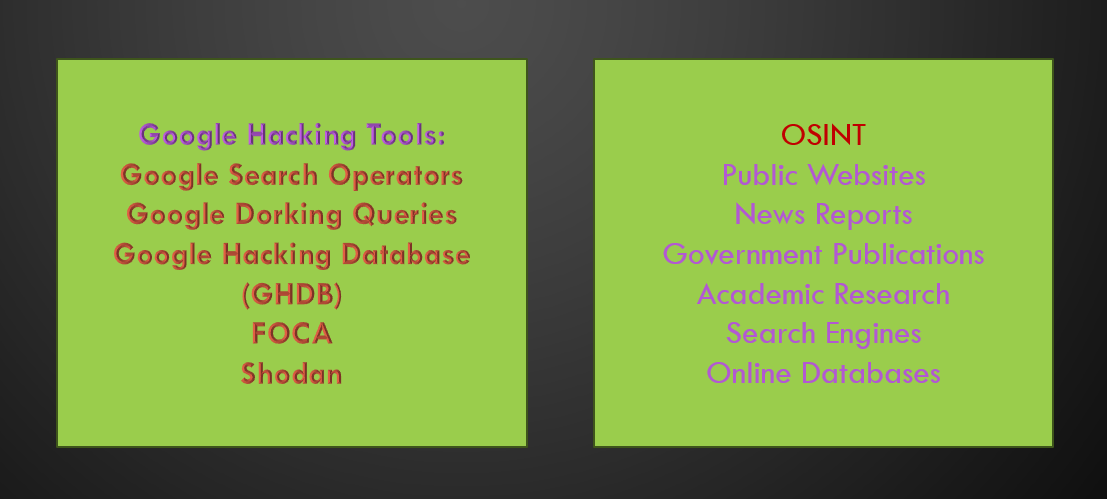
Open-Source Intelligence (OSINT): A Powerful Tool for Threat Assessment
OSINT involves gathering information from publicly available sources to understand potential threats and adversaries. By analyzing the vast amount of data published online, organizations can gain valuable insights into reconnaissance techniques used by malicious actors. This information can be used to identify vulnerabilities within their own systems and networks, as well as to develop counterintelligence strategies.
Reconnaissance, often the initial stage of an attack, involves gathering information about a target. By understanding reconnaissance techniques and applying them to your own organization, you can uncover the sensitive information that malicious actors might exploit. This information can be found on various platforms, including websites, social media, and other publicly accessible sources.
The Power of OSINT: Uncovering Hidden Information
OSINT as a Tool for Attackers:
-
Targeted Strategies: OSINT can provide attackers with valuable information to develop tailored strategies.
-
Social Engineering: Locating personal information can expose individuals to blackmail, entrapment, or other social engineering tactics.
-
Physical Access: Knowing a target’s routine or location can facilitate physical attacks or theft.
Common Sources of OSINT:
-
Publicly Available Information:
-
IP addresses
-
Address ranges
-
Contact information
-
Physical address
-
Whois records, SEC filings, telephone directories
-
-
Social Media:
-
Personal and professional information
-
Potential vulnerabilities
-
-
HTML Code:
-
IP addresses, web servers, operating systems
-
File paths, developer/administrator information
-
Development practices, security awareness
-
-
Metadata:
-
Author names, modification history
-
Cross-referencing with other domains
-
Key Takeaways:
-
OSINT is a valuable resource for both organizations and attackers.
-
Understanding the types of information available through OSINT can help organizations identify and mitigate potential risks.
-
By proactively monitoring and protecting their online presence, organizations can minimize the potential for exploitation through OSINT.
Summary: OSINT and its Potential Risks
Open-source intelligence (OSINT) can provide attackers with valuable information to develop strategies for compromising a target. By leveraging publicly available data from sources like social media, websites, and public records, attackers can gather sensitive information about individuals and organizations. This information can be used for various malicious activities, such as blackmail, social engineering, and physical attacks. Understanding the potential risks of OSINT and implementing appropriate security measures is crucial to protecting organizations and their employees from exploitation.
Google Hacking and Search Tools:
Google’s Search:
This section explores “Google hacking,” the art of utilizing Google’s search engine capabilities to uncover sensitive information. While not targeting Google itself, this technique leverages advanced search operators to extract valuable insights.
Mastering Search Operators:
-
Quotes (” “): Specify exact phrases for precise searching.
-
Exclusion (-): Exclude results containing specific terms with the minus sign.
-
Logical Operators (AND/OR): AND forces both terms to be present, OR allows either (use caps AND or pipe symbol |). Examples showcase the difference:
-
user account password AND database (stricter)
-
(user OR account) AND password AND database (more flexible)
-
(user OR account) AND (password OR database) (even broader)
-
-
Targeting Search (site:, filetype:, related:, allintitle:, allinurl:, allinanchor:):
-
site: limits search to a specific domain (e.g., site:security.com)
-
filetype: restricts results to specific file types (e.g., filetype:pdf)
-
related: finds websites similar to a provided one (e.g., related:whitehouse.gov)
-
allintitle:, allinurl:, allinanchor: match terms within specific page sections (title, URL, anchor text)
-
-
URL Modifiers: Refine search results through URL additions:
-
&pws=0: Disables personalized results
-
&filter=0: Bypasses Google’s filters
-
&tbs=li:1: Prevents autocorrection
-
By mastering these operators, you can craft powerful Google hacking queries to uncover potentially sensitive information, aiding security research or ethical hacking endeavors.
Remember: Responsible use is crucial. Always obtain permission before attempting to identify vulnerabilities on someone else’s systems.
Unveiling Vulnerabilities with Google Hacking Tools
Beyond People Search:
Google hacking extends beyond researching individuals. It allows you to identify potentially vulnerable web servers and applications, or even uncover unintended information leaks.
The Google Hacking Database (GHDB):
-
Maintained by: Offensive Security
-
Purpose: Provides a list of search strings (“Google Dorks”) to discover vulnerabilities. These strings can help you find:
-
Vulnerable web application versions.
-
Publicly accessible files containing passwords.
-
Exposed webcams.
-
-
Learning Tool: GHDB serves as a valuable resource for learning effective search operators for uncovering potential security risks.
Shodan: Search Engine for Devices
-
Function: Shodan (shodan.io) acts as a search engine specifically for internet-connected devices.
-
Data Gathering: Employs banner grabbing to collect device details like:
-
Device type
-
Firmware/OS/App version
-
Vendor and ID information
-
-
Additional Information: Gathers metadata such as IP address, hostname, and geographic location.
-
FOCA: A tool for discovering metadata and hidden information in documents found through search engines.
-
Dual Purpose:
-
Popular hacking tool for finding vulnerable IoT and ICS devices.
-
Offers enterprise features for monitoring your own devices and networks.
-
Important Note:
Always remember to use these tools responsibly and ethically. Obtain proper permission before attempting to identify vulnerabilities on someone else’s systems.
Social Engineering Through Email and Social Media Profiling
Understanding Email Harvesting:
Attackers often begin by harvesting email addresses to identify employees within a target company. Since most companies use real names in email addresses, this allows them to:
-
Match Emails to Social Media: Identify personal accounts belonging to employees, potentially revealing vulnerabilities for social engineering attacks.
-
Associate Emails with Job Roles: Public information about senior staff (websites, prospectuses, SEC filings) can help attackers understand employee roles and tailor their attacks.
Common Email Harvesting Techniques:
-
Purchasing Lists: Attackers may buy email lists from spammers or obtain legitimate sales leads.
-
Web Scraping: Automated tools crawl websites and social media platforms to extract email addresses.
-
Dictionary Attacks: Testing variations of potential email addresses against a company domain.
Social Media Profiling:
Once email addresses are acquired, attackers leverage social media to build profiles on employees:
-
Public Information Gathers: Publicly available information on business networking sites (e.g., LinkedIn) can reveal personal interests, habits, and even locations.
-
Social Engineering Opportunities: By understanding an employee’s background and habits, attackers can craft personalized social engineering tactics.
-
Data Aggregation Tools: Specialized software (e.g., pipl.com, peekyou.com) can combine data from various sources to create detailed user profiles.
Protecting Yourself:
-
Privacy Settings: Be mindful of privacy settings on social media platforms.
-
Limited Information Sharing: Avoid oversharing personal information online.
-
Strong Passwords: Maintain strong and unique passwords for all accounts.
-
Security Awareness: Educate yourself and colleagues about social engineering techniques.
By understanding these tactics, individuals and organizations can be better prepared to defend against social engineering attacks.
Uncovering Network Secrets: DNS and Website Harvesting
Attackers can employ various techniques to glean valuable information about a network or website. Here’s a breakdown of some common methods:
DNS Reconnaissance:
-
Whois Lookups: Examining a company’s domain registration records through a whois lookup can reveal contact details, ownership information, and sometimes server details.
-
Zone Transfers (DNS Misconfiguration):
-
Attackers may exploit misconfigured DNS servers to perform a zone transfer.
-
This grants them access to the complete list of hosts within a domain, exposing the network structure.
-
Tools like nslookup or dig can be used to attempt zone transfers.
-
Website Ripping and Analysis:
-
Website Rippers: Tools like Httrack can download and analyze the entire website code, potentially revealing:
-
Vulnerabilities in the website code or underlying application.
-
Forgotten or outdated pages containing sensitive information.
-
Email addresses harvested from the website content.
-
Following these techniques can provide attackers with:
-
Server Locations: Geolocation tools can pinpoint the approximate location of servers using harvested IP addresses.
-
Network Structure: A complete list of hosts within a domain can reveal the network architecture if a zone transfer is successful.
-
Security Weaknesses: Analyzing website code can expose vulnerabilities that attackers can exploit.
Remember: These techniques can also be used for legitimate purposes like website security testing or penetration testing, but always with proper authorization.
Summary: Google Hacking and Related Techniques
Google hacking involves using advanced search techniques to uncover information about individuals, organizations, and their systems. This includes techniques like:
-
Google Hacking Database (GHDB): A resource for finding vulnerable web applications and obtaining sensitive information.
-
Email and Social Media Profiling: Gathering information about individuals through email addresses and social media profiles.
-
DNS and Website Harvesting: Acquiring network details and website information using DNS lookups and website rippers.
These techniques can be used by attackers to identify vulnerabilities and gather sensitive data. It’s essential for organizations to be aware of these methods and implement appropriate security measures to protect themselves.

Leave a Reply